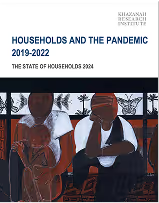

The State of Households 2018 aims to illustrate the diverse realities of Malaysian households in relation to demographic changes in the workforce and our long term developmental trajectory. In this series of six short articles, we take readers on a brief tour down this narrative. The first three articles explore the diversity of Malaysian households. We begin with household income.
An average Malaysian household has 4 members, with around 2 income-receiving members. Malaysia’s mean and median household income in 2016 were RM6,958 and RM5,228 respectively. Most Malaysians will find these numbers surprising, but perhaps this reaction is justified. Simple averages overlook many of the nuances across Malaysia’s 30 million strong population. Below, we dive deeper into these differences to more accurately describe the very different lives we Malaysians live.
.png)
One pattern obscured by simple averages are the differences across states. Although the national mean household income is almost RM7,000, this misrepresents the experience of households in most states. Outside Selangor and the Federal Territories of Putrajaya and Kuala Lumpur, most households make less than the average. On the other hand, the mean household income in Greater Kuala Lumpur is nearly twice the national average at RM10,427.
We test three potential factors that may contribute to this diversity of household incomes: demography, level of urbanisation, and level of education.
Intuitively, demographics could play a role in the divergent incomes across states. As the centre of economic activity, people migrate into Kuala Lumpur for jobs. Therefore, because there are more employed adults per household in Kuala Lumpur, the average household in Kuala Lumpur should be richer than those in other states,. However, in our analysis, we find an insignificant difference in the employed adults per household across states. Instead, urbanisation proves a stronger explanation. Across every state in Malaysia, we find that Malaysians living in urban areas earn 70% more than those in rural areas.
Ultimately, we find that the most significant explanation for divergent household incomes is the level of education of household heads. Household heads with a degree earn 3.6 times the income of those without a degree. In Malaysia, only a third of employed persons have a degree. Thus, education plays a major role in the distribution of income in Malaysia. On an individual level, human capital – the level of education, skills, and experience – is key to determining employment and earning outcomes. Improving the level and opportunity of education for all will be crucial in lowering the gap in household income
On a broader level, human capital is also key to development. According to the World Bank’s 2018 Changing Wealth of Nations report, developed countries consistently have high income and high human capital. In high-income OECD countries such as the United States, human capital per capita amounts to over seven times more than that of upper-middle-income countries such as Malaysia. Thus, education is again key to developing Malaysia into a high-income nation.
Simple averages of household income obscure patterns and reasons for the distribution of income. We find that income varies incredibly by state, and find that this variation is primarily explained by education. Education is key for both raising the household standards of living and for national development. Despite taking a more nuanced analysis on income, income alone cannot provide a complete picture of the experience of households. In our next article, we explore the changing patterns in expenditure over time and across income levels.














